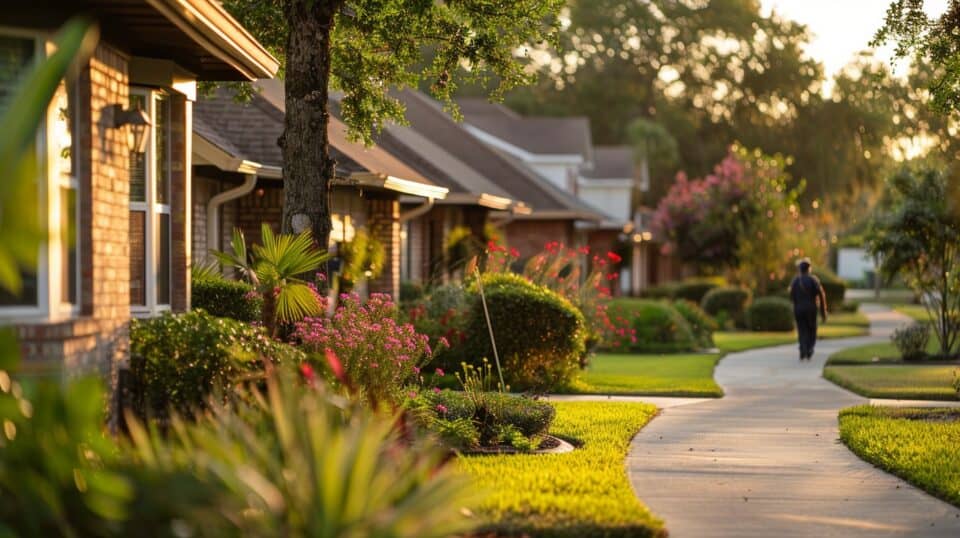Retiring comfortably with rental properties isn’t about luck—it’s about strategy. Many women dream of financial freedom through real estate, but don’t know where to start. This guide cuts through the noise.
We’ll show you exactly how many properties you need and how to get there.
I’ve spent 12 years helping clients build wealth through real estate investments. My approach focuses on steady cash flow and long-term appreciation. We’ll explore key concepts like the 1% Rule and diversification.
By the end, you’ll have a clear roadmap to retire on your terms with rental income.
Key Takeaways
You need about 5-7 rental properties generating $5,000-$7,000 monthly income for a comfortable retirement.
Use the 1% Rule (monthly rent should be 1% of property price) and 50% Rule (half of rental income goes to expenses) to evaluate properties.
Diversify your portfolio across different property types and locations to reduce risk.
Set aside 1% of property value annually for repairs and maintenance costs.
Aim for a 6-7% cash-on-cash return on your rental property investments.
Table of Contents
Understanding the Basics of Rental Properties for Retirement

Rental properties can be a game-changer for your retirement plans. They offer steady passive income and potential tax benefits, making them an attractive option for long-term financial security.
Defining passive income from rentals
Passive income from rentals offers a steady cash flow without daily work. Property owners receive monthly payments from tenants, covering mortgage costs and generating profit. This income stream requires minimal effort once the property is secured and occupied, unless you need major renovations and improvements to the property.
Real estate investing, even on a small scale, remains a tried and true means of building an individual’s cash flow and wealth. – Robert Kiyosaki
Rental properties can provide substantial returns. For example, seven homes could generate $60,000 annually for retirement. Next, we’ll explore how to estimate average rental income.
Estimating average rental income
Building on the concept of passive income from rentals, estimating average rental income is crucial for retirement planning. Real estate investors typically aim for a 6% cash-on-cash return.
A $1 million investment in rental properties could generate $60,000 annually at this rate. For a more modest $4,000 monthly retirement income, you’d need about $685,714 invested, roughly equivalent to five homes.
To calculate potential earnings, research annual average rent rates for similarly valued properties in your target area. Consider a portfolio of seven rental homes, totaling $840,000 in investment.
This could yield $100,800 yearly gross rental income, translating to a 6.6% cash-on-cash return. Keep in mind, these figures serve as starting points for strategy development, not exact predictions.
Factor in variables like property taxes, insurance costs, and maintenance expenses to refine your estimates.
How Many Rental Properties Do You Need to Retire?

The number of rental properties needed for retirement varies based on your financial goals and lifestyle. Your target retirement income and property selection strategy play key roles in determining this number.
Calculating target retirement income
Calculating target retirement income forms the cornerstone of your rental property retirement strategy. This crucial step determines how many properties you’ll need to achieve financial independence.
- Assess current expenses: Track monthly spending on essentials like housing, food, healthcare, and utilities.
- Estimate future needs: Factor in inflation, potential healthcare costs, and lifestyle changes for retirement.
- Apply the 80% rule: Aim for 80% of your pre-retirement income as a starting point for retirement needs.
- Include other income sources: Add Social Security benefits, pensions, or 401(k) distributions to your calculation.
- Determine rental income goals: Subtract other income sources from your target to find the gap rental properties need to fill.
- Use the 1% rule: Aim for monthly rent to equal 1% of the property’s purchase price for optimal cash flow.
- Apply the 50% rule: Estimate operating expenses at 50% of gross rent to account for repairs, vacancies, and management costs.
- Calculate net rental income: Subtract mortgage payments and operating expenses from gross rent to find your true passive income.
- Divide target by net income: This reveals the number of properties needed to meet your retirement goals.
- Adjust for diversification: Consider spreading investments across different locations or property types to mitigate risk.
- Account for leverage: Using mortgages can increase your property count but impacts cash flow and risk.
- Plan for tax advantages: Factor in potential deductions for mortgage interest, depreciation, and operating expenses.
- Consider appreciation: Long-term property value increases can supplement rental income in retirement.
Using the 1% Rule and 50% Rule for property selection
The 1% Rule and 50% Rule serve as crucial tools for women seeking rental properties for retirement. The 1% Rule states that monthly rent should equal at least 1% of the property’s purchase price.
For example, a $200,000 property should generate $2,000 in monthly rent. The 50% Rule estimates that half of your rental income goes towards expenses, excluding mortgage payments. This helps calculate potential cash flow.
These rules simplify property evaluation and comparison. A $300,000 property renting for $3,000 monthly meets the 1% Rule. After applying the 50% Rule, you’d estimate $1,500 for expenses.
The remaining $1,500 covers mortgage payments and potential profit. Women can use these guidelines to quickly assess multiple properties and build a retirement portfolio that aligns with their financial goals.
Analyzing the Financial Aspects

Analyzing your finances is key to a solid retirement plan. You’ll need to crunch the numbers on your future expenses and income sources.
Estimating annual retirement expenses
Tracking current spending habits forms the foundation for estimating annual retirement expenses. Tools like Excel, Mint.com, or YNAB help women analyze their monthly outflows. Financial planners often suggest budgeting 70-80% of pre-retirement income for retirees.
This accounts for reduced costs in areas like commuting and work attire, but increased healthcare expenses.
A realistic retirement budget considers inflation, typically 2-3% annually. Housing, healthcare, food, and leisure activities usually comprise the largest expense categories. For example, a $60,000 annual retirement income might allocate $18,000 for housing, $12,000 for healthcare, $9,000 for food, and $6,000 for travel.
Regular budget reviews ensure financial plans stay on track as life circumstances change.
Adjusting current expenses for retirement
Retirement planning demands a critical look at your current spending habits. You’ll need to factor in inflation, which can erode purchasing power over time. Tools like Excel, Mint.com, or YNAB help track expenses and project future costs.
Cut unnecessary expenses now to boost retirement savings.
The best time to plant a tree was 20 years ago. The second best time is now. – This wisdom applies perfectly to retirement planning and property investment.
Retirees often face new costs – healthcare typically increases, while work-related expenses decrease. A practical approach: calculate your target monthly income, then subtract Social Security and other fixed income sources.
The remainder guides how many rental properties you’ll need. For example, five cash-bought properties meeting the 1% and 50% rules could generate $5,000 monthly.
Selecting the Right Rental Properties

Selecting the Right Rental Properties
Location is key for rental success. Smart investors focus on areas with strong job markets and growing populations.
Location and property value assessment
Location reigns supreme in real estate investing. Smart investors prioritize areas with high tenant demand and strong appreciation potential. They analyze local market conditions, vacancy rates, and average rents.
Savvy women focus on emerging neighborhoods or established areas with solid growth prospects.
Property value assessment requires a keen eye for potential. Investors compare similar properties in the area to gauge fair market value. They factor in needed repairs or upgrades when calculating potential returns.
Understanding cost basis and leveraging tax advantages can maximize profits. Next, we’ll explore how to evaluate tenant demand and cash flow stability.
Evaluating tenant demand and cash flow stability
Cash flow stability hinges on consistent tenant demand. Research local vacancy rates, average rents, and tenant demographics. Aim for areas with low turnover and strong rental markets.
A 7% cash-on-cash yield from debt-free properties can provide steady income. Prioritize locations with economic growth and stable job markets.
Analyze historical rent trends and future projections. Look for properties in neighborhoods with good schools, amenities, and transportation. These factors attract long-term tenants and ensure reliable cash flow.
Consider using property management software to track income and expenses. Next, let’s explore how to effectively manage your rental properties.
Managing Your Rental Properties

Managing rental properties takes work. You need a system to handle tenant issues and keep your properties in good shape. Property management software can help you track rent payments and maintenance requests.
Regular inspections and prompt repairs keep tenants happy and protect your investment.
Importance of property management
Property management is crucial for rental property success. It streamlines operations, reducing stress and workload for owners. Effective management ensures timely rent collection, proper tenant screening, and efficient maintenance – key factors in maximizing your investment’s return.
A good property manager handles advertising, bookkeeping, and even legal compliance, freeing you to focus on growing your portfolio.
Hiring a local manager or using property management software can significantly boost efficiency. These tools simplify tasks like rent collection and tenant communication. They also help track expenses, schedule maintenance (don’t forget to clean the chimney!), and generate financial reports.
With proper management, you can turn your rental properties into a reliable income stream for retirement.
Good property management is the cornerstone of a successful rental investment strategy. – Warren Buffett
Addressing repairs and maintenance costs
Repairs and maintenance costs can quickly eat into your rental income. Smart landlords set aside 1% of the property value annually for these expenses. Create a reserve account to cover unexpected issues like plumbing leaks or HVAC failures.
This proactive approach helps avoid financial stress when problems arise.
Regular upkeep, like cleaning the storm drain, prevents costly emergencies. Use property management software to track maintenance schedules and tenant requests. Consider hiring a local manager to handle day-to-day tasks, controlling costs while maintaining property oversight.
This strategy allows you to focus on growing your portfolio of 5–10 properties generating $5,000-$7,000 monthly income for a comfortable retirement.
Diversifying Your Rental Portfolio

Diversifying your rental portfolio spreads risk and boosts income potential. Mix property types and locations to create a stronger, more stable investment base.
Benefits of diversification in property investments
Spreading your investments across different types of rental properties safeguards your retirement income. Mix apartments, single-family homes, and commercial spaces in various locations.
This strategy shields you from market fluctuations in any one area or property type. A diverse portfolio of 28 properties could generate $33,600 monthly rental income with $19,600 net operating income after expenses.
Diversification also allows you to tap into different tenant demographics and income levels. You might own high-end condos in urban centers and affordable housing in suburban areas.
This approach balances risk and potential returns. Aim for a 7% cash-on-cash yield on your investments. Compare costs and rental rates across the US to find the most profitable markets for your portfolio.
Strategies for acquiring diverse properties
Diversifying your rental portfolio is crucial for long-term success. Here are effective strategies for acquiring diverse properties:
- Target different property types: Invest in a mix of single-family homes, multi-unit buildings, and commercial spaces. This spread reduces risk and captures various market segments.
- Explore multiple locations: Buy properties in different neighborhoods, cities, or even states. This guards against localized economic downturns and taps into various growth markets.
- Consider varying price points: Include both affordable and high-end rentals in your portfolio. This attracts a wider range of tenants and balances cash flow with appreciation potential.
- Mix short-term and long-term rentals: Combine traditional leases with vacation rentals or corporate housing. This strategy maximizes income potential and adapts to market shifts.
- Leverage REITs and crowdfunding: Invest in real estate investment trusts or crowdfunding platforms. These options allow access to larger, more diverse property portfolios with lower capital requirements.
- Partner with other investors: Form joint ventures or real estate investment groups. This pooling of resources enables acquisition of larger, more diverse properties.
- Use 1031 exchanges: Defer capital gains taxes by exchanging properties. This technique allows for strategic portfolio diversification without immediate tax consequences.
- Implement value-add strategies: Buy undervalued properties and improve them. This approach creates equity and increases rental income across diverse property types.
Protecting Your Investment

Protecting your rental properties goes beyond basic insurance. Smart landlords use comprehensive coverage and regular property inspections to safeguard their investments. These steps help catch small issues before they become costly problems.
Insurance and risk management for rental properties
Landlord insurance is crucial for rental property portfolios. Obie Insurance, an online broker, offers coverage in all 50 states with average savings of 25%. This insurance protects against unforeseen accidents or disasters, safeguarding your investment.
Create a reserve account for unexpected repairs or maintenance costs – it’s a smart move for long-term financial stability.
Understanding local market dynamics is key to risk management. Study vacancy rates, average rents, and tenant demographics in your area. This knowledge helps you make informed decisions about property selection and pricing.
By staying informed and prepared, you’ll minimize potential losses and maximize your rental income potential.
Building a Realistic Retirement Plan

Setting clear goals and timelines is key to a solid retirement plan. Read on for more tips to secure your financial future.
Setting realistic timelines for retirement goals
Realistic retirement timelines hinge on rental investment profitability, current income, and spending habits. Track progress with small milestones to stay motivated. For example, aim to acquire seven rental properties over 10 years, generating $60,000 annually.
This approach allows for gradual portfolio growth while adjusting to market changes.
A solid retirement plan might target five cash-purchased properties yielding $5,000 monthly. Alternatively, build a $840,000 portfolio of seven rentals, producing $100,800 yearly with a 6.6% cash-on-cash return.
Adjust goals based on local real estate markets and personal financial capacity. Regular portfolio reviews ensure you’re on track to meet your retirement income needs.
Integrating other sources of income
Diversifying income streams boosts retirement security. Smart investors mix rental properties with stocks, bonds, and personal loans. According to Sujeet Patel, vacation rental expert at Guys Gab, “A balanced portfolio hedges against market fluctuations.” Tools like Excel or YNAB help track multiple income sources.
Aim for a mix that generates $60,000 annually from $1 million invested at 6% cash-on-cash return.
Landlord insurance protects rental income from unforeseen events. Consider high-yield savings accounts or peer-to-peer lending platforms like Lending Club for additional passive income.
Explore tax advantages of different income sources to maximize returns. Regularly review and adjust your income strategy to account for inflation and changing market conditions.
People Also Ask
How many rental properties do I need to retire?
It depends on your cost of living, desired income, and return on investment. Use a retirement calculator to crunch numbers. Factor in inflation, tax advantages, and potential property value increases.
What’s the rental property retirement formula?
Calculate: (Desired Retirement Income – Other Income Sources) / (Average Rental Income per Property). This gives a rough estimate of properties needed. Don’t forget expenses, vacancies, and market fluctuations.
How can rental properties hedge against inflation?
Real estate often appreciates over time. Rents typically rise with inflation. This protects your purchasing power. It’s a solid strategy compared to some other asset classes.
What tax benefits come with rental properties?
Plenty! Write off mortgage interest, property taxes, and repairs. Claim depreciation expense. These deductions can significantly lower your income tax burden. Consult a tax pro for specifics.
Should I use debt financing for rental properties?
Leveraging can boost returns but increases risk. Low mortgage rates make borrowing attractive. Be cautious – overleveraging can lead to foreclosure if the market turns. Balance is key.
How do I maximize ROI on rental properties?
Buy in growing areas. Screen tenants carefully. Keep maintenance up-to-date. Refinance when rates drop. Consider a cash-out refinance to fund more purchases. Always do thorough underwriting before buying.



